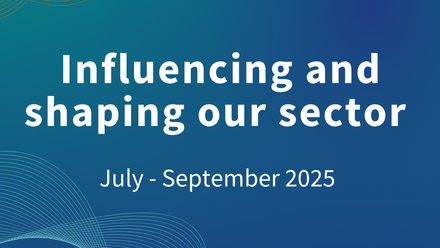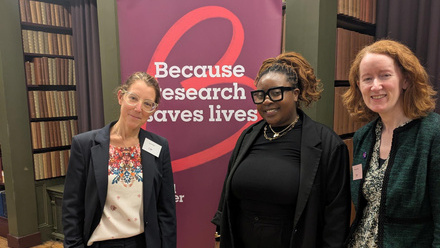Concr new report on 'other' cancers covered by pharmaphorum
In a new report, ‘Helping others: unlocking the potential of ‘other’ cancers through predictive analytics’, the Concr team – co-founders Matthew Foster and Matthew Griffiths, together with CEO Irina Babina – looked at how ‘common’ cancers like lung, breast, prostate, pancreas, and colorectal cancers ‘dominate’ not just clinical trials, but also data collection efforts more generally.
What they found is a ‘critical imbalance’, a research and funding landscape where ‘other’ cancers are left in the dark, and the patients remain with unmet needs. Yet, with predictive analytics, the Concr team believe a new and shared light can be shed on these less-common cancers. Matthew Foster provided further details to pharmaphorum.
Less common, but not less frequent: The critical need for bringing ‘other’ cancers into research’s focus
Cancer research often focuses on common types, reflecting the economic priorities of the global cancer drug market. In 2023, the oncology market was valued at approximately $150 billion, yet, over 70% of this market is dominated by treatments for common cancers such as lung and breast cancer. Drugs targeting rare or ‘less common’ cancers collectively represent a much smaller slice of the market, often struggling to secure investment, due to smaller patient cohorts and higher variability in outcomes. Nonetheless, ‘other’ cancers can occur more frequently than ‘common’ types.
This results in data imbalance – a considerable issue for predictive modelling and/or drug development for ‘common’ cancers; exacerbated for ‘other’ cancers. Nevertheless, so the Concr report proposes, it is the similarities between the ‘common’ and the ‘other’ that hold promises of addressing this discrepancy.
“There are many differences in types of disease, tissue, and manifestation, initiation and progression, but there is a remarkable amount of similarity as well,” explained Foster. He continued:
One of the main challenges in common cancers is limited patient heterogeneity. When you start to study, say, breast cancer, for example, you would choose a patient cohort that express a particular marker that you're creating a drug for. By doing this, it's likely that across the spectrum of all cancers, or even within all breast cancers, you've already selected in your clinical trial a very narrow subset.
“The reality is that you are being very, very selective for a particular phenotype or set of disease characteristics,” he said. “What we are proposing is: why not integrate that heterogeneity in that original narrow cohort? Why not start by analysing a broader heterogeneous cohort to begin with?”
Heterogeneity vs homogeneity: Circumventing accuracy ceilings with predictive modelling
Despite being grouped as ‘other’, these cancers account for nearly 50% of patients and 55% of cancer-related deaths. Their diversity and small patient groups make outcome predictions challenging, seen to be limiting the development of effective treatments. But this variability could be a hidden strength for predictive modelling.
Predictive models thrive on data diversity. Models trained on homogeneous data hit accuracy ceilings, but when including data from more diverse cancer types – such as from the 'other' categories – robustness is enhanced. Unlike models relying on extensive data from a single cancer type, incorporating 'other' cancers enriches the dataset with biological variability, leading to more accurate predictions across all types.
“Typically, analytics technologies, like those we work with at Concr, are being developed with the expectation that you can access hundreds to thousands of patients’ data to train on or be used for development to create predictions,” said Foster. “That indirectly then begins to exclude cancers where gathering datasets of this size is going to be more difficult or less feasible. For example, within a subset of head and neck cancer, it's going to be quite difficult to find thousands of patients that fit the exact genomic profile that you would like to target an immunotherapy towards. That's going to be a much smaller population than for breast cancer.”
“Commonly, we have found that when you train predictive models you hit a ceiling of accuracy for a wider generalisation, based upon how well your training data represents the user cases you're going to put your model into,” Foster continued. “Multiple fields of machine learning have shown that you can hit an accuracy limit: no matter how big and complicated you make your models, you still hit a threshold for accuracy [… And] one of the key ways that you can break this, go in the back door, or sidestep this is to try and use a more diverse range of data.”
The benefits of diversity in algorithmic training: Looking to ‘biological units’
Essentially, what Concr demonstrates is that training their algorithms on smaller, yet more diverse, data can lead to increased accuracy, due to the broader biological variability within that training context. The outcome basically begins to reflect more the reality of cancer heterogenicity across populations.
“This allows it to be able to look at robust patterns across different cases,” stated Foster. “I think that's really the key thing here: looking for robustness or reproducibility of patterns. What we're training these algorithms to do, is to pick up these robust and generalisable patterns across different data types. The way to do that is to go across different cancers, so breadth, and then there's also depth.”
In short, to bridge gaps between common and rare cancers, Concr focuses on 'biological units' – clusters of traits that drive cancer behaviour and treatment response. These units allow movement beyond the limitations of tissue-specific classifications, creating predictive models that apply to multiple cancers. Such models can identify patterns across diverse types, improving outcomes even for cancers not well-represented in the training data; the ‘other’ cancers.
Predictive oncology & FarrSight
Ultimately, then, Concr claims leveraging the biological diversity of these lesser-studied cancers holds the key to advancing predictive oncology for all cancers. Expanding predictive modelling to include diverse data from ‘other’ cancers can drive new drug development, more tailored clinical trials, and enact a shift towards truly personalised medicine.
“There's so much data that you can collect, [but] the real question we tried to answer is: do you need a broader range of data coupled with a better model, or do you need more data to make many narrow algorithms that are very good at very particular tasks?” Foster mused.
Concr's own predictive engine, FarrSight, is a Bayesian proprietary model of human cancer biology.
“FarrSight looks across many different data types of a cancer and tries to draw these robust or generalisable patterns that I’ve talked about,” explained Foster. “It uses those hidden patterns to predict for a particular patient their general outcome and what you would expect their outcome to be under a number of different therapeutics. This Bayesian method is the way that we tie together those different data types […] We looked at the genome and the transcriptome of patients, and we also looked at clinical factors; such age, sex, etc.”
“When I say robust patterns, I mean, those units of biology that might actually be present across different people in different cancer types,” he continued. “Bayesian analysis in simplistic terms is trying to understand how one set of variables affects another. This allows us to understand really complex relationships between different processes, such as how the genomic status of a cancer influences the different cell behaviours, and how this influences total sensitivity of these cells to a therapy. We don't prime the algorithm to pick a particular signature. We let the algorithm go from a blank slate and pick what it sees, across these populations, as the most explainable of the biological units that define treatment response.”
Within the wider context of the predictive oncology space, the benefits for the advancement of the field are clear.
“Predictive oncology is a massive field,” stated Foster. “It encompasses lots of innovations, and there's still a lot that needs to be done – it's a very exciting space […] Predictive oncology began by looking at really trying to find these very detailed signatures that would explain human biology or a human response to cancer therapeutics. It goes back to the philosophical roots of the human genome project […] The problem is, as you scale up those analyses, it gets computationally more intense. Experimentally, to collect evidence, it becomes more difficult. Many people have stepped back from these narrow approaches, dissuaded by the seeming complexities [… but] Concr has developed modelling to introduce methods that can handle that chaos.”
“How do you realistically measure 10,000 or 5,000 genes from a particular patient? Concr is using the statistical approach to answer this starter question, feeding that into our models to allow us to provide an explanation or more mechanistically interpretable output. [And] I think that's where the field of predictive oncology is going: much further together,” concluded Foster.






